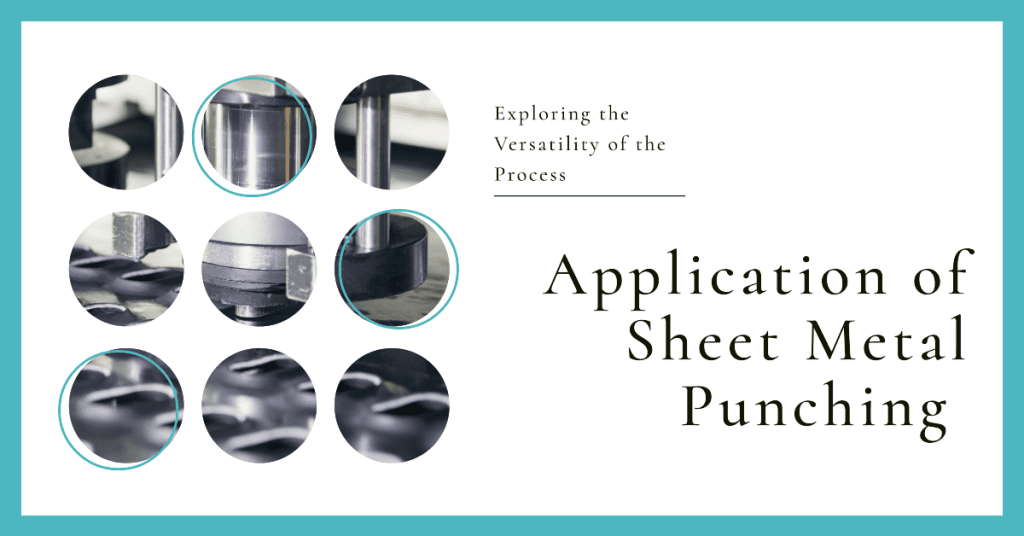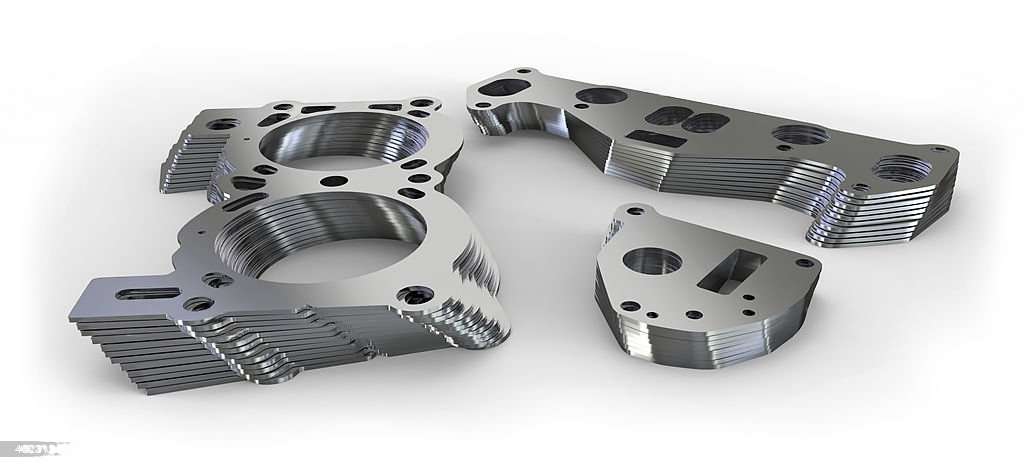
Punched metal parts
Sheet metal punching is a versatile manufacturing process that finds applications in various industries. This process involves using specialized tools to create holes, shapes, and features in sheet metal with precision and efficiency. The ability to customize tooling and adapt to different materials and designs makes sheet metal punching an attractive option for a wide range of applications.
In this comprehensive guide, We’ll explore sheet metal punching and its advantages over other metal fabrication techniques in various industries such as automotive, electronics, construction, and aerospace. Specific applications with key benefits will be covered.
Automotive Applications: Sheet Metal Punching in the Automotive Industry

Punched metal parts
Sheet metal punching plays a vital role in the automotive industry, where precision and efficiency are crucial. This manufacturing process is used for a variety of applications in the automotive sector. Here are some common automotive applications of sheet metal punching:
- Body Panels: Sheet metal punching is extensively used to fabricate body panels, including doors, hoods, fenders, and trunk lids. These components require precise punching to achieve the desired fit and appearance.
- Chassis Components: Sheet metal punching is employed to manufacture chassis components such as brackets, mounts, and reinforcements. These components provide structural support and ensure the integrity and stability of the vehicle.
- Exhaust Systems: Sheet metal punching is used to create holes and perforations in exhaust systems to facilitate proper gas flow and reduce backpressure. This improves engine performance and fuel efficiency.
- Interior Components: Various interior components of vehicles, such as seat brackets, console panels, and dashboard parts, are fabricated using sheet metal punching. These components require precise punching to ensure proper fit and functionality.
- Heat Shields: Sheet metal punching is employed in the manufacturing of heat shields used to protect sensitive components from high temperatures. These shields are essential for maintaining the safety and performance of the vehicle.
Table: Automotive Applications of Sheet Metal Punching
| Application | Description |
|---|---|
| Body Panels | Manufacturing doors, hoods, fenders, and trunk lids |
| Chassis Components | Producing brackets, mounts, and reinforcements for structural support |
| Exhaust Systems | Creating holes and perforations for proper gas flow |
| Interior Components | Fabricating seat brackets, console panels, and dashboard parts |
| Heat Shields | Manufacturing shields to protect components from high temperatures |
Sheet metal punching is instrumental in the automotive industry, allowing for the efficient production of various components that contribute to the performance, safety, and aesthetics of vehicles.
Electronics and Telecommunications Applications: Precision Punching for Small Components

The sample of sheet metal plate in the light blue scene. The manufacturing process of automotive parts by progressive die.
Sheet metal punching is also widely utilized in the electronics and telecommunications industries, where small, precise components are essential for electronic devices and communication systems. Here are some applications of sheet metal punching in these industries:
- Enclosures and Chassis: Sheet metal punching is used to manufacture enclosures and chassis for electronic devices such as computers, servers, routers, and amplifiers. These components provide structural support and protect the internal electronic components.
- Connectors and Terminals: Precision punching is employed to create connectors and terminals used in electronic connectors, printed circuit boards (PCBs), and cable assemblies. These components enable electrical connections and signal transmission.
- Heat Sinks: Sheet metal punching is utilized to fabricate heat sinks that dissipate heat generated by electronic components. Heat sinks ensure proper thermal management and prevent overheating.
- Racks and Cabinets: Sheet metal punching is employed in the production of racks and cabinets used in data centers, telecommunications infrastructure, and server rooms. These components provide housing and organization for electronic equipment.
- Cable Management Systems: Sheet metal punching is utilized to create cable management systems, including cable trays, clips, and brackets. These components facilitate neat and organized cable routing and management.
Table: Electronics and Telecommunications Applications of Sheet Metal Punching
| Application | Description |
|---|---|
| Enclosures and Chassis | Manufacturing structural components for electronic devices |
| Connectors and Terminals | Producing connectors and terminals for electrical connections |
| Heat Sinks | Fabricating heat dissipation components for thermal management |
| Racks and Cabinets | Manufacturing housing and organization systems for electronic equipment |
Construction Applications: Sheet Metal Punching in the Construction Industry
Sheet metal punching plays a vital role in the construction industry, providing efficient solutions for various applications. This manufacturing process is used extensively in the construction sector for its versatility and precision. Here are some common construction applications of sheet metal punching:
- Structural Components: Sheet metal punching is employed to fabricate structural components used in buildings, bridges, and infrastructure projects. These components include brackets, connectors, plates, and reinforcements.
- Roofing and Cladding: Sheet metal punching is utilized in the manufacturing of roofing and cladding panels, which provide protection and insulation for buildings. Precise punching ensures the proper alignment and fit of these panels.
- HVAC Systems: Sheet metal punching is used to create air ducts, vents, and other components for heating, ventilation, and air conditioning (HVAC) systems. These components facilitate the efficient flow of air in buildings.
- Facades and Architectural Features: Sheet metal punching is employed to fabricate facades, decorative panels, and architectural features for aesthetic and functional purposes. These components enhance the visual appeal of buildings.
Table: Construction Applications of Sheet Metal Punching
| Application | Description |
|---|---|
| Structural Components | Manufacturing brackets, connectors, plates, and reinforcements |
| Roofing and Cladding | Producing panels for roofing and cladding |
| HVAC Systems | Creating air ducts, vents, and HVAC components |
| Facades and Features | Fabricating facades, decorative panels, and architectural components |
Medical Applications: Precision Punching for Healthcare Innovations
Sheet metal punching is also widely employed in the medical field, where precision and quality are paramount for healthcare innovations. Here are some applications of sheet metal punching in the medical industry:
- Medical Equipment: Sheet metal punching is used to manufacture components for medical equipment, such as diagnostic devices, surgical instruments, and imaging systems. These components require precise punching to ensure reliability and accuracy in medical procedures.
- Medical Furniture: Sheet metal punching is utilized in the production of medical furniture, including hospital beds, examination tables, and carts. These components provide structural support and ergonomic functionality.
- Medical Cabinets and Carts: Sheet metal punching is employed to fabricate cabinets and carts used for medical storage and transport. These components ensure efficient organization and accessibility of medical supplies.
- Medical Device Enclosures: Sheet metal punching is used to create enclosures for medical devices, protecting sensitive electronic components and ensuring the durability and safety of the devices.
Table: Medical Applications of Sheet Metal Punching
| Application | Description |
|---|---|
| Medical Equipment | Manufacturing components for diagnostic and surgical devices |
| Medical Furniture | Producing hospital beds, examination tables, and medical carts |
| Medical Cabinets and Carts | Fabricating storage and transport solutions for medical supplies |
| Medical Device Enclosures | Creating protective enclosures for medical devices |
Applications in Manufacturing Industry
In the manufacturing industry, sheet metal punching is utilized for a wide range of applications. Some notable examples include:
- Metal furniture: Sheet metal punching allows for the production of precise holes and features in metal furniture components, ensuring proper assembly and functionality.
- Appliances: Various components in appliances such as ovens, refrigerators, and washing machines are manufactured through sheet metal punching.
- Equipment: Sheet metal punching is employed in the fabrication of equipment components, including enclosures, brackets, and frames.
Advantages of Sheet Metal Punching
Sheet metal punching offers numerous advantages over other metal fabrication techniques. Let’s explore these benefits:
| Advantage | Description |
|---|---|
| Precise and Accurate | Sheet metal punching allows for precise hole placement, shape creation, and feature replication, ensuring accuracy in component fabrication. |
| High Production Rate | Sheet metal punching can be automated, allowing for high-speed and efficient production, reducing manufacturing time, and increasing productivity. |
| Cost-Effective | Sheet metal punching is a cost-effective method due to its high production rate, minimal material wastage, and efficient use of resources. |
| Versatility | Sheet metal punching can be used with various sheet metal materials, allowing for a wide range of applications and design possibilities. |
| Complex Geometries | Sheet metal punching enables the creation of complex shapes, curves, and contours, providing design flexibility and aesthetic appeal. |
| Repeatable Results | With proper tooling and setup, sheet metal punching ensures consistent and repeatable results, maintaining product quality and reliability. |
Sheet metal punching is a versatile and efficient process with a wide range of applications across various industries. Its advantages in terms of precision, production rate, cost-effectiveness, and design flexibility make it a preferred choice for many manufacturers.
Conclusion
Sheet metal punching is a versatile and efficient process that offers numerous benefits in various applications. It provides precise hole placement, high production rates, cost-effectiveness, versatility, and the ability to create complex geometries. With proper safety measures in place, sheet metal punching can be performed with efficiency and reliability. Whether in the automotive, electronics, construction, medical, or manufacturing industries, sheet metal punching plays a vital role in achieving high-quality, functional, and aesthetically pleasing components.
Prolean’s Sheet Metal Punching Services
At Prolean, we specialize in providing high-quality sheet metal punching services for a wide range of industries. Our team of experienced professionals is dedicated to delivering precision, efficiency, and customer satisfaction. With state-of-the-art equipment and a commitment to excellence, we ensure that your sheet metal punching needs are met with the utmost precision and quality. Contact us today to learn more about our sheet metal punching services and how we can assist you in your manufacturing projects.
FAQs
What types of materials can be used for sheet metal punching? Sheet metal punching can be performed on a variety of materials, including mild steel, stainless steel, aluminum, copper, brass, and various alloys.
What are the typical tolerances achievable in sheet metal punching? The achievable tolerances in sheet metal punching depend on factors such as material thickness, punch and die clearance, and the precision of the punching machine. Typically, tolerances within ±0.1 mm to ±0.25 mm can be achieved.
Can sheet metal punching be used for both prototypes and large-scale production? Yes, sheet metal punching is suitable for both prototype development and large-scale production. The process can be easily adapted to accommodate varying quantities and production requirements.
What are the advantages of sheet metal punching over other metal fabrication methods? Sheet metal punching offers advantages such as high production rates, precise hole placement, cost-effectiveness, design flexibility, and the ability to create complex geometries, making it a preferred choice over other metal fabrication methods.




0 Comments